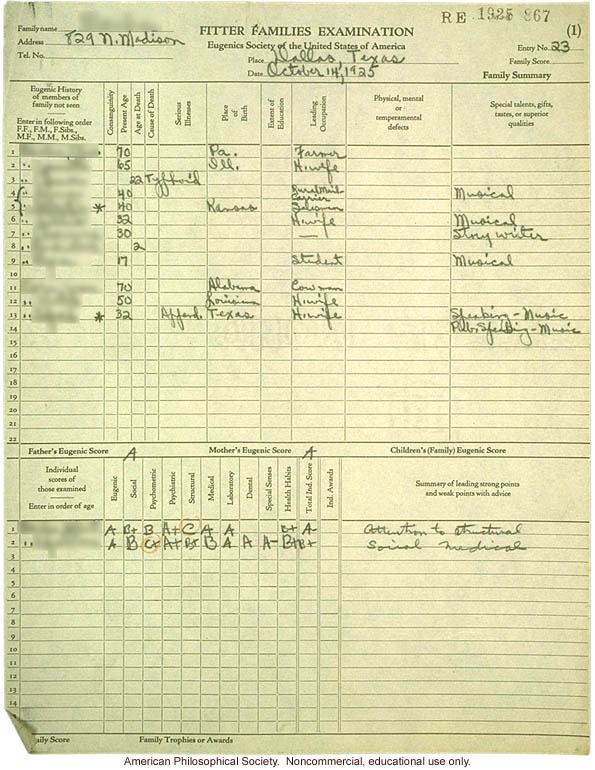Texas
There
were no known eugenic sterilizations in Texas.
Passage of Law(s)
Gordon Lincecum was a biologist and physician in Texas in the mid
1800’s. Today Lincecum would be called a eugenicist; he proposed a bill
in Wisconsin in 1849 stating that those who were mentally handicapped
as well as those who possessed undesirable traits should be sterilized.
The bill was never even brought to a vote but this does show the first
attempt in the United States at compulsory sterilizations (Head).
As Julius Paul (p. 648) explains, even though Texas never had a law
authorizing the sterilization of residents, the president of the State
Medical Association of Texas, F. E. Daniel, as early as in 1893
supported eugenic practices by claiming that sterilization by
castration for “certain institutionalized persons” and as “a penalty
for sexual crimes” would lead to “race improvement” (Painter).
Texas legislators did not act upon this call for sterilizations (Paul,
p. 648), but as Hopkins shows, the Texas Medical Association advocated
that medical insanity be established by medical experts, not a jury
trial (p. 29), and the first decades of the 20th century, as well as
after Buck v. Bell in 1927 called for the adoption of a sterilization
law (focusing on the insane; Hopkins, pp. 36-37).
Texas
also had “Fitter Family Contests.” Below is a “Fitter
Family Examination” form from a contest in Dallas in 1925. In fact,
Hopkins details an extensive series of related "Better Baby Contests"
in Texas (pp. 60-75), specifically in Houston, Forth Worth, Austin, San
Antonio, Longview, Mineral Wells, and Marshall by 1915 (p. 64), as well
as a series of eugenics courses at universities (p. 86).
 (Photo origin: http://www.eugenicsarchive.org/html/eugenics/static/images/188.html
(Photo origin: http://www.eugenicsarchive.org/html/eugenics/static/images/188.htmlMost recently, after Congress passed legislation in 1975 assigning an organization to each state that would help protect the rights of people with disabilities, in 1977 Advocacy, Inc (now Disability Rights Texas) began in Texas under former Governor Dolph Briscoe to advocate for the disabled (Disability Rights Texas).
Process of the Law
As Julius Paul pointed out, Texas’
laws for consent helped protect Texans from sexual
sterilizations. “Texas Common Law requires patient’s consent for
all surgical procedures. The Legislature has made special
exception for emergency treatment in state institutions, but
has specifically excepted sexual sterilizations and frontal lobotomies [from being performed under these circumstandes],
which left these two operations intact in Texas law,” notes Paul in his
commentary on post-WWII practices in Texas (p. 647). While in other
states, patients were coerced into consenting to sexual sterilizations,
Texas's consent laws appear to have been followed.
Limitations on Reproduction of the “Unfit”
Most Mexican immigrants were short time workers that intended to return to Mexico, and that therefore did not apply for citizenship. Some Texans were threatened by the potential loss of citizens' jobs to Mexicans and by the risk of, as a judge put it, the "intermingling of racial blood." However, many Texans were aware of the extent to which the economy relied on immigrant workers. When this judge gained the support of eugenicists on a national level to make multiple pleas to the government for restrictions the number of Mexicans allowed into Texas, he was unsuccessful to have his advocacy turned into law(Hopkins, pp. 39-42). Texas had anti-miscegenation laws and laws preventing the marriage of those “deemed incapable of consenting,” which came to mean those deemed “mentally defective.” Legislature passed in the 1920s stated that "Where one, then because of insanity, is incapable of consenting, there is an impediment which will render voidable the attempted contract" (Hopkins, pp. 32-33). The Texas Medical Association also advocated for the passage of a marriage law that prevented those with a mental illness or intellectual disability from marrying (Hopkins, pp. 32-35), but such plans did not come to fruition, and marriage laws focused on preventing interracial marriages between Blacks and whites (not Latinos), not reproduction of the "unfit."
Segregation
Texas’s
eugenic practice thus emphasized segregation, in insane asylums.
In the early 1900s, the number of asylums in Texas grew rapidly.
The asylums were meant to permanently remove the unfit from society,
and within them, the unfit were not allowed to see members of the
opposite sex. While there were no laws legalizing sterilization of the
unfit, there was not a large chance of reproduction once one was deemed
mentally ill (Hopkins, p. 27).
Ultimately,
Hopkins' study falls in line with Larson's (1995) argument that the
strength of the family, the emphasis of family systems of caring,
mistrust in the government and reluctance to transfer authority to it,
and emphasis on (white) citizen's rights, and a lack of strength of
social progressivism hampered the establishment of eugenic
sterilization in Texas. The state, with a large number of Mexican
immigrants, was also not willing to extend negative eugenic measures to
these immigrants, in part lest a cheap pool of labor be reduced
(Hopkins, pp. 38-43)
Bibliography
Disability Rights Texas. 2010. “History.” Available at <http://www.advocacyinc.org/who-we-are/history/>.Head, Tom. 2006. “Forced Sterilization in the United States: A Short History.” Available at <http://civilliberty.about.com/od/gendersexuality/tp/Forced-Sterilization-History.htm>.
Hopkins, Ramona L. 2009. “Was There a Southern Eugenics?: A Comparative Case Study of Eugenics in Texas and Virginia, 1900-1940.” Masters Thesis, History Department, University of Houston.
Larson, Edward. 1995. Sex, Race, and Science: Eugenics in the Deep South. Baltimore: Johns Hopkins University Press.
Paul, Julius. 1965. “‘Three Generations of Imbeciles Are Enough’: State Eugenic Sterilization Laws in American Thought and Practice.” Washington, D.S.: Walter Reed Army Institute of Research.
Painter, George. 2004. “The Sensibilities of our Forefathers.” Available at <http://www.glapn.org/sodomylaws/sensibilities/texas.htm>.